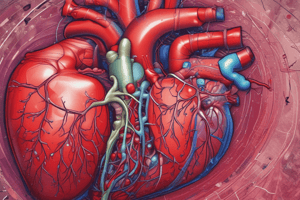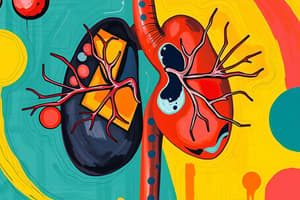Podcast
Questions and Answers
What is the primary action of verapamil and diltiazem on the heart?
What is the primary action of verapamil and diltiazem on the heart?
- Block L-type Ca 2+ channels in cardiac tissues (correct)
- Enhance myocardial contractility
- Increase heart rate and conduction speed
- Increase O2 demand during cardiac work
What is the mechanism by which ranolazine reduces cardiac contraction?
What is the mechanism by which ranolazine reduces cardiac contraction?
- It decreases sodium entry, which reduces Ca2+ overload. (correct)
- It inhibits calcium entry into the cardiac muscle.
- It promotes increased blood flow to ischemic areas.
- It increases potassium efflux from cardiac cells.
Which class of medications is most commonly used to prevent angina?
Which class of medications is most commonly used to prevent angina?
- Calcium channel blockers
- Long-acting nitrates
- β-blockers (correct)
- Ranolazine
What adverse effect is associated with the use of ranolazine?
What adverse effect is associated with the use of ranolazine?
When should nitroglycerin be used for angina management?
When should nitroglycerin be used for angina management?
What is the primary symptom of ischemic heart disease?
What is the primary symptom of ischemic heart disease?
Which condition is primarily caused by an imbalance between myocardial oxygen demand and supply?
Which condition is primarily caused by an imbalance between myocardial oxygen demand and supply?
Which parameter, when increased, leads to an increase in oxygen demand?
Which parameter, when increased, leads to an increase in oxygen demand?
What is the primary action of antianginal drugs?
What is the primary action of antianginal drugs?
Which class of drugs has been primarily used for over 100 years to treat angina pectoris?
Which class of drugs has been primarily used for over 100 years to treat angina pectoris?
What is the conversion product of organic nitrates that stimulates vascular relaxation?
What is the conversion product of organic nitrates that stimulates vascular relaxation?
How do organic nitrates primarily affect blood vessels?
How do organic nitrates primarily affect blood vessels?
Which of the following is NOT a way antianginal drugs decrease oxygen demand?
Which of the following is NOT a way antianginal drugs decrease oxygen demand?
What is the primary action of b-blockers in treating angina pectoris?
What is the primary action of b-blockers in treating angina pectoris?
Which of the following is a consequence of b-blocker use in angina treatment?
Which of the following is a consequence of b-blocker use in angina treatment?
Which class of drugs can cause bronchoconstriction in asthma patients?
Which class of drugs can cause bronchoconstriction in asthma patients?
How do calcium channel blockers affect blood pressure?
How do calcium channel blockers affect blood pressure?
Which of these medications is considered a dihydropyridine calcium channel blocker?
Which of these medications is considered a dihydropyridine calcium channel blocker?
What impact do b-blockers have on renin release?
What impact do b-blockers have on renin release?
Which of the following is a cardiovascular adverse effect of b-blockers?
Which of the following is a cardiovascular adverse effect of b-blockers?
What is the primary mechanism by which calcium channel blockers prevent angina?
What is the primary mechanism by which calcium channel blockers prevent angina?
What is the main effect of nitrates on preload?
What is the main effect of nitrates on preload?
How do nitrates affect cardiac oxygen demand?
How do nitrates affect cardiac oxygen demand?
What is a significant drawback of using oral nitrates?
What is a significant drawback of using oral nitrates?
What adverse effect is commonly associated with nitrates due to excessive vasodilation?
What adverse effect is commonly associated with nitrates due to excessive vasodilation?
Why is a nitrate-free period recommended in patients using nitrates long term?
Why is a nitrate-free period recommended in patients using nitrates long term?
What is the primary action of b-adrenergic receptor blockers in the treatment of angina?
What is the primary action of b-adrenergic receptor blockers in the treatment of angina?
Which of the following is NOT a common use for b-blockers?
Which of the following is NOT a common use for b-blockers?
What is a potential side effect of orthostatic hypotension caused by nitrate use?
What is a potential side effect of orthostatic hypotension caused by nitrate use?
Which class of antiarrhythmic drugs includes sodium channel blockers?
Which class of antiarrhythmic drugs includes sodium channel blockers?
What is the effect of Quinidine on the heart?
What is the effect of Quinidine on the heart?
Which of the following are adverse effects of Quinidine? (Select all that apply)
Which of the following are adverse effects of Quinidine? (Select all that apply)
Adenosine activates adenosine receptors to decrease K+ efflux.
Adenosine activates adenosine receptors to decrease K+ efflux.
What are the therapeutic uses of Amiodarone?
What are the therapeutic uses of Amiodarone?
Class II antiarrhythmic drugs are known as ______ blockers.
Class II antiarrhythmic drugs are known as ______ blockers.
Which of the following drugs is a Class IV antiarrhythmic?
Which of the following drugs is a Class IV antiarrhythmic?
Propranolol increases automaticity of the SA node.
Propranolol increases automaticity of the SA node.
What is a common adverse effect of Verapamil?
What is a common adverse effect of Verapamil?
What effect do Class III antiarrhythmics generally have?
What effect do Class III antiarrhythmics generally have?
Class V antiarrhythmic drug includes which of the following?
Class V antiarrhythmic drug includes which of the following?
Flashcards are hidden until you start studying
Study Notes
Angina Pectoris
- Characterized by chest pain, a primary symptom of ischemic heart disease.
- Often linked to coronary artery disease (atherosclerosis) due to an imbalance between myocardial oxygen demand and supply.
- Determinants of oxygen demand include heart rate, cardiac contractility, preload, and afterload.
- Increased cardiac work leads to higher oxygen demand.
Antianginal Drugs
- Primary goal: Decrease oxygen demand in the heart.
- Mechanisms include lowering heart rate, contractility, preload, and afterload.
- Types of drugs used to treat angina:
- Organic Nitrates
- β-Adrenergic Receptor Blockers
- Calcium Channel Blockers
- Ranolazine
Organic Nitrates
- Used for over 100 years to treat angina.
- Mechanism of action: Converted to nitric oxide (NO), enhancing cGMP formation which leads to vascular relaxation.
- Major effects:
- Venous dilation predominates, decreasing preload, thus lowering cardiac work and oxygen demand.
- Some arterial dilation reduces afterload, further decreasing oxygen demand.
- Can improve coronary blood flow by dilating large coronary arteries.
- Pharmacokinetics:
- Sublingual nitrates are effective for acute angina attacks.
- Long-acting forms can be used for prevention.
- Adverse effects may include headaches, hypotension, and reflex tachycardia.
- Tolerance can develop; an 8-10 hour nitrate-free interval is recommended.
β-Adrenergic Receptor Blockers
- Block β-adrenergic receptors, reducing sympathetic nervous system responses.
- Used for prevention of angina, hypertension, arrhythmias, and heart failure.
- Reduce heart rate and contractility, leading to lower oxygen demand.
- Reduce renin release which decreases angiotensin II, thus lowering blood pressure and afterload.
- Potential adverse effects:
- Respiratory issues (e.g., bronchoconstriction).
- Cardiovascular effects (e.g., bradycardia).
- CNS effects (e.g., insomnia, depression).
- Abrupt withdrawal can worsen angina.
Calcium Channel Blockers (CCBs)
- Three classes:
- Phenylalkylamines (e.g., verapamil)
- Benzothiazepines (e.g., diltiazem)
- Dihydropyridines (e.g., nifedipine).
- Mechanism: Block L-type calcium channels, impacting cardiac and vascular smooth muscle.
- Effects on blood vessels:
- Relaxation of arterial smooth muscle reduces blood pressure and afterload, decreasing oxygen demand.
- Modest vasodilation in coronary arteries may enhance oxygen supply.
- Effects on heart:
- Verapamil and diltiazem slow heart rate and conduction, reducing overall cardiac work and oxygen demand.
Ranolazine (Ranexa®)
- A newer drug approved to treat angina.
- Mechanism: Reduces sodium entry in cardiac muscle, decreasing calcium overload and cardiac contraction, thus lowering oxygen demand.
- Adverse effects can include arrhythmias, constipation, nausea, and dizziness.
Treatment Strategy for Stable Angina
- For infrequent attacks: Sublingual nitroglycerin for acute relief.
- For frequent prevention: Use of β-blockers or CCBs or ranolazine, or long-acting nitrates.
- If one drug is insufficient, combinations can be employed:
- β-blocker with long-acting nitrates.
- β-blocker with dihydropyridine CCB.
- Combination of all options with ranolazine.
Electrical Properties of the Heart
- Heart function relies on electrical impulses for contraction and relaxation.
- Abnormal heart rhythms, known as arrhythmias or dysrhythmias, can manifest as too fast, too slow, or irregular beats.
Types of Arrhythmias
- Disturbances in heart rhythm arise from:
- Automaticity: abnormal generation of action potentials, leading to tachycardia or ectopic pacemakers.
- Conduction pathway: issues like atrioventricular (AV) block or reentry circuits.
Vaughan Williams Classification of Antiarrhythmic Drugs
- Class I: Sodium channel blockers (e.g., Quinidine, Lidocaine)
- Class II: Beta blockers (e.g., Propranolol, Metoprolol)
- Class III: Potassium channel blockers (e.g., Amiodarone)
- Class IV: Calcium channel blockers (e.g., Verapamil, Diltiazem)
- Class V: Other agents including Adenosine
Class I: Sodium Channel Blockers
- Quinidine:
- Blocks sodium channels, delays repolarization, and slows impulse conduction.
- Therapeutically used for supraventricular and ventricular arrhythmias.
- Adverse effects: Diarrhea, nausea, blurred vision, ventricular arrhythmias, hypotension.
Class II: Beta Blockers
- Propranolol:
- Lowers automaticity of the SA node, decreases AV conduction and myocardial contractility.
- Used for arrhythmias from sympathetic overactivity and supraventricular tachycardia.
- Adverse effects: Heart block, heart failure, sinus arrest, hypotension.
Class III: Potassium Channel Blockers
- Amiodarone:
- Delays repolarization and reduces automaticity, conduction velocity, and contractility.
- Effective against various arrhythmias, used widely despite its risks.
- Adverse effects: Pulmonary toxicity, sinus arrest, corneal microdeposits, thyroid dysfunction, skin photosensitivity.
Class IV: Calcium Channel Blockers
- Verapamil:
- Decreases automaticity in the SA node, delays AV nodal conduction, and reduces contractility.
- Commonly used to manage ventricular rates in atrial fibrillation/flutter and terminate certain tachycardias.
- Adverse effects: Bradycardia, hypotension, heart failure, peripheral edema.
Class V: Other Agents
- Adenosine:
- Activates adenosine receptors to increase K+ efflux, hyperpolarizing cardiac cells.
- Slows SA node automaticity and AV node conduction; used for rapid termination of supraventricular tachycardia.
- Adverse effects: Sinus bradycardia, dyspnea, hypotension, flushing.
Key Concepts
- Refractory Period: Duration where heart cells are unresponsive to stimuli, critical for preventing continuous arrhythmias.
- Grapefruit juice may elevate Amiodarone levels, increasing toxicity risk, particularly with diuretics that reduce potassium.
Studying That Suits You
Use AI to generate personalized quizzes and flashcards to suit your learning preferences.





